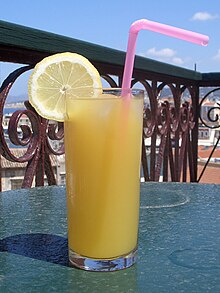Drinking straw
A drinking straw (also Getränkehalm or drinking tube ), due to its original production from straw and straw called, is a tool with which fluids to drink can suck at this.
The diameter is, for example, 6 mm and the length ranges from about 15 to over 30 cm. As disposable products, drinking straws have thin walls and are typically made of polyethylene or polypropylene .
Drinking tubes are also made from thick-walled plastics, stainless steel , break-proof glass , corn starch (noodles), silicone , paper or bamboo .
Straws were used by the Sumerians . A drinking straw was patented by Marvin C. Stone in 1888.
history
The first known drinking straws were made by the Sumerians for drinking beer. Presumably this should avoid the uptake of solid fermentation by- products that sink to the bottom. The oldest drinking straw still in existence was found in a Sumerian grave from 3000 BC. Found in BC, it consists of a gold tube with an embedded lapis lazuli . Similar metallic objects called bombillas were used in Argentina and neighboring countries , which served as both a straw and a strainer when drinking mate tea.
In the 1800s, straws made from Lolch (ryegrass) came into fashion because they were cheap and soft. Unfortunately, they became soft over time in liquids. For this reason, Marvin C. Stein patented the modern paper drinking straw in 1888. He got this idea on a hot day while drinking a mint julep , as the cocktail had a grassy taste when drinking . For the drinking straw, he wrapped a strip of paper around a pencil and glued the end on. He later improved production with a simple machine that coated the outside of the straw with wax so that the glue would no longer dissolve in the bourbon .
Typical shape
The drinking straws for mass use are disposable items and are available in practically every imaginable color and length and with a wide variety of diameters. Various decorations, for example with phosphors , can also be found for party needs. They are available in the form of knots, spirals, waves, etc. The most common shapes are straight and rigid or can be bent at the top with a bellows. At the lower end, the stalks are either closed straight or cut off at an angle in order to pierce beverage cartons at a given point.
More straws
- Paper drinking straws are well established in the club scene and in drinking bars. A major disadvantage is the short period of use, which amounts to one to two hours.
- Drinking straws made of silicone or hard, thick-walled plastic are most similar to the common disposable plastic straw . They are reusable and dishwasher safe.
- Glass drinking straws can also be used as often as you like and can also be cleaned in the dishwasher . They are fragile and can cause injury.
- Bamboo drinking straws are partially reusable. They will soon show signs of wear.
- Stainless steel drinking straws are very stable and rust-free and can be reused. Usually a brush is also included for cleaning. The metal-like taste can be seen as a disadvantage.
- Drinking straws made from durum wheat semolina (so-called pasta stalks ) are repurposed noodles . The common diameter is 0.6 cm and the length is 22.5 to 25 cm. The drinking straws are not reusable and only retain their hardness for up to two hours. A distinctive feature, however, is its own taste.
- Drinking straws made of polylactide (PLA for short, a bioplastic) are biodegradable within 90 days. PLA drinking straws have the same properties as conventional plastic straws.
Special forms
The upper end can have holes instead of a large opening (so-called sensory straw ), so that the drink is more evenly distributed in the mouth.

Another variant is the molding of a kind of spoon at the lower end of the drinking straw. This means you can stir as well as drink without having several "tools" in the glass.
Drinking straws are still being produced that can be pulled out telescopically to almost double the length.
Some straws are not straight, but rather twisted several times in the upper part.
Straws can be provided with vitamins and aromas on the inside ; when drinking these are then dissolved and absorbed with the drink.
In South America , mate tea is drunk through a metal spoon-sieve drinking tube ( bombilla ), the sieve of which at the bottom prevents the tea leaves of the mate tea from being sucked in.
Environmental protection and legal situation
According to a conservative estimate, around 36.4 billion drinking straws are thrown away every year in the European Union.
The German Ministry of the Environment claimed that plastic straws are one of the most common products found among the garbage in the seas. In December 2018, a directive was therefore passed in the European Parliament according to which plastic single-use products, including drinking straws, will no longer be allowed in the European Union from 2021. The directive aims to avoid environmental damage amounting to 22 billion euros by 2030.
In Taiwan, a ban on single-use plastic straws for large restaurant chains from 2019 and a general reduction in single-use plastic straws by 2030 was decided.
The European Parliament has passed strict regulations on the future handling of plastic waste, which many manufacturers are now putting under pressure. In order to reduce the pollution of the world's oceans with plastic waste, the following legal regulations have been issued:
From 2021, single-use plastic straws are to be banned across the EU . Even single-use plastic dishes such as plates, cups and cutlery should be banned by this time. Cotton swabs and drink stirrers must then no longer be made of plastic.
Europeans cause 25 million tons of plastic waste every year. In Germany alone, 6 million tons of plastic waste are generated every year. Together with Ireland and Estonia , Germany is at the top of the EU in terms of the amount of plastic waste.
Effects of alcohol consumption
There is the unsubstantiated thesis that you get drunk faster if you drink an alcoholic beverage through a drinking straw. There are probably two reasons for this: On the one hand, the drink is transported through the mouth in small sips through the drinking straw, so that a larger part of the alcohol can get into the blood through the oral mucosa in the mouth. On the other hand, alcohol is broken down to a certain extent in the stomach by the enzyme alcohol dehydrogenase . However, this degradation process cannot work for the alcohol that gets directly into the blood through the oral mucosa. A third hypothesis claims that more alcohol vapors would be inhaled with a straw and absorbed more quickly via the lungs.
Physical Properties
The maximum length that a drinking straw can have so that one can still drink depends on the size of the negative pressure that the drinker can create in the mouth in relation to the environment. It is limited upwards by the geodetic suction height , which is around ten meters for water at normal pressure.
literature
Dirk Wüstenberg: New entrepreneurial obligations according to the single-use plastic directive , in: European Journal for Commercial Law (EuZW) 2019, pp. 633–638.
Web link
Individual evidence
- ↑ a b "The Amazing History and the Strange Invention of the Bendy Straw," Derek Thompson, The Atlantic , November 22, 2011.
- ↑ Patent US375962 : Artificial straw. Inventor: Marvin Stone.
- ↑ Alternative straws tested - 07/2019 - Alternative straws. Retrieved May 27, 2019 .
- ^ Gastropack GmbH , drinking straws made from bioplastics.
- ^ [1] Seas At Risk : Single-use Plastics and the Marine Environment - Leverage points for reducing single-use plastics , page 7, accessed on May 30, 2020
- ↑ Initiative against microplastics - where Great Britain, Italy and Sweden are ahead of us. February 5, 2019, accessed February 5, 2019 .
- ↑ Alternative straws tested - 07/2019 - Plastic ban in the EU. Retrieved May 27, 2019 .
- ↑ Bayerischer Rundfunk: Strohhalm: Straws cause so much garbage . April 24, 2018 ( br.de [accessed February 5, 2019]).
- ↑ Christoph Drösser ( Right? ): Rausch through the pipe ( page no longer available , search in web archives ). In: The time . No. 52/1997




